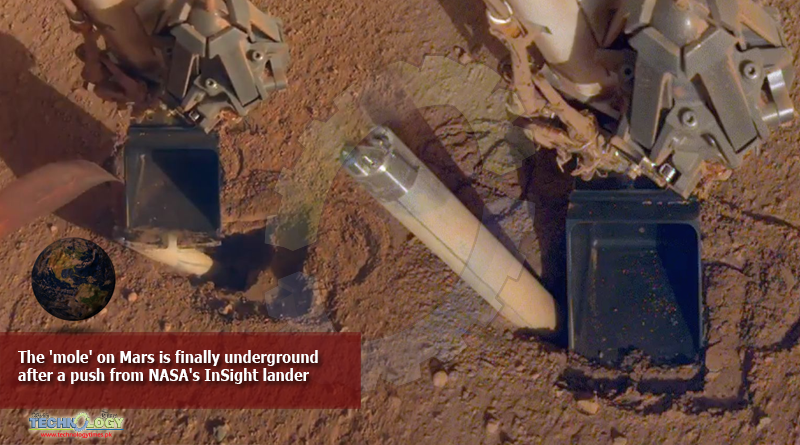There’s a light at the end of the tunnel for the first mole to burrow into the surface of Mars, scientists hope.The mole is one of the lander’s three key tools to accomplish that but for more than a year, mission personnel have struggled to deploy it.

Not a furry , of course; the term is the nickname for the instrument formally known as the Heat Flow and Physical Properties Package on board NASA’s InSight lander mission. The lander, which touched down on Mars in November 2018, is designed to give scientists a look inside the Red Planet and gather data to help them understand its geology and internal structure.
But after serious challenges, the mole has finally reached a new milestone. “After several assists from my robotic arm, the mole appears to be underground,” the official Twitter account for the mission wrote yesterday (June 3). “It’s been a real challenge troubleshooting from millions of miles away. We still need to see if the mole can dig on its own.”
The mole consists of a drillbit-like assembly full of heat sensors that are attached to the main body of the lander by a taillike tether. The instrument is designed to hammer itself up to 16 feet (5 meters) into the Martian surface near InSight’s home in a region called Elysium Planitia. The idea is that as it burrows down, the mole’s temperature sensors will study the rock it digs through and evaluate how energy moves out from the planet’s core.
It’s a completely new type of instrument for Mars but, although the team tested it extensively in chambers of dirt on Earth, such analogs can never precisely match circumstances on the Red Planet. And so, just about as soon as the mole set out on its Martian dig, it struggled, getting stuck or backing out. Since then, InSight personnel have tried a range of tactics to get the mole digging successfully, running into obstacles every time.
The most recent technique involved using an arm on the lander to gently push the end of the mole as it dug to keep the probe from bouncing out. That’s a delicate proposition since the InSight team needed to be careful to not damage the tether connecting the mole to the lander.
After several assists from my robotic arm, the mole appears to be underground. It’s been a real challenge troubleshooting from millions of miles away. We still need to see if the mole can dig on its own. More from our @DLR_en partners: http://bit.ly/3gSvB38 #SaveTheMole
But according to a new blog post from Tilman Spohn, the German space agency scientist leading the mole team, this technique finally yielded some progress. The mole is now nearly entirely buried in the Martian soil, he wrote, with the scoop at the end of the lander arm near the surface. All told, that means the mole has moved about 2.8 inches (7 centimeters) into the rock between March 11 and May 30.
(Because the mission’s instruments were supposed to be fully deployed by now and project personnel have other work to complete, the lander can only work on the mole problem once a week, slowing progress further, Spohn wrote.)
Next will come what the team calls the “free-mole” test, as the instrument progresses deeper than the lander’s arm can assist. From now on, the mole will have to make its own way; whether it can likely depends on how much traction it can find in the column of dust and rock surrounding it.
However, external forces may soon interfere with the mole campaign, according to the blog post. “Winter is approaching on Mars’ northern hemisphere and dust storm season will begin soon,” Spohn wrote. “The atmosphere is already getting dustier and the power generated by the solar panels is decreasing. This may affect our ability to performing energy consuming operations with the arm in the near future. Stay tuned and keep your fingers crossed.
Originally Publish at: https://www.space.com/
